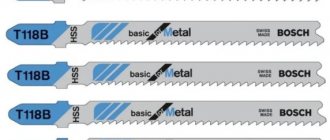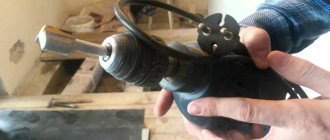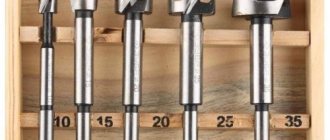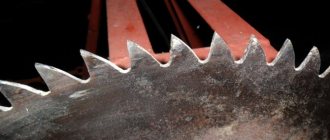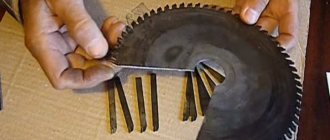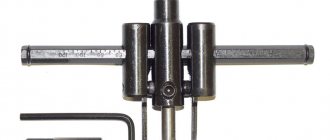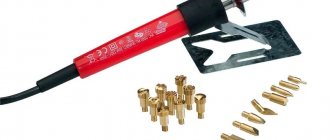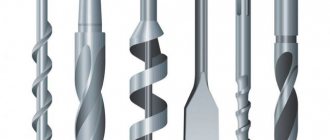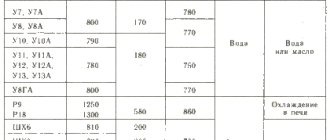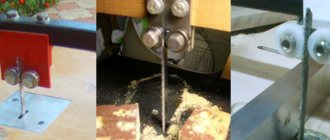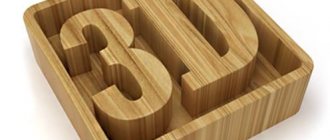Today we will analyze the types of files for an electric jigsaw, because when choosing, the buyer has many questions. There are a lot of types of saws, because with a jigsaw you can cut not only wood, the list is much longer. Therefore, in this article we will figure out which saws are best for cutting simple wood, and which chipboard or fiberboard, and which saws are used to cut various types of metal.
And of course, we will pay attention to the markings, so after reading this article, you will begin to understand which file is suitable for which work. It’s not for nothing that there are different letters and numbers on the files. What do they mean? We will analyze all this using the example of popular models from Bosch, since they are of good quality and their price is very low.
If you have ever been to a tool store, you have seen that there are letters and numbers on the shank of any saw. Let's figure out what they mean.
The letter T means the type of fastening, that is, T-shaped (Fig. 1). There is also U, which is much less common (Fig. 2).
The numbers on the shank mean:
The first number is the length:
- 1 - standard short, length up to 75 mm.
- 2 - average length, up to 90 mm
- 3 - extended, up to 150 mm
- 7 - the longest (over 150 mm)
The following letters indicate the size of the teeth: A, B, C, D
Tooth A is the smallest, so all metal files have A, for example T118A means a file with a T-shaped shank, short, very fine tooth. Next, respectively, B - a slightly larger tooth (most often these are saws with fine teeth for plywood, chipboard, fiberboard and wood for a clean cut). Files with the letters C and D - with the largest teeth, for rough sawing on wood.
There are also saws with two letters at the end, for example the T119BO model, so let’s look at what the last letter means:
- F - bimetal (the coolest, highest quality)
- R - with reverse tooth
- X - universal for wood, metal and plastic.
- O - for a curved cut (cutting a circle, for example, usually thin, so that the file can be turned straight while sawing).
- P - thick options for sawing strictly at the exact selected angle (thick, do not bend, so they cut perfectly). A prominent representative is the T144DP, which costs significantly more than the standard ones.
The main purpose of an electric jigsaw is cutting wood. There are a huge number of files for this purpose and they are all different. Let's go in order.
If you need to cut ordinary boards and you don’t care about the quality of the cut, its cleanliness, you work for speed (for example, cutting ordinary boards for firewood or for a fence), then buy jigsaw files with large teeth. Thanks to this, the sawing speed will be high, and if you work with a jigsaw in pendulum mode, then everything will be just fine.
In addition, also pay attention to the length of the saw, since you won’t be able to cut a board or block 70 mm thick (for example) with a regular saw, you will need an extended one.
Well, the third nuance when choosing is thickness, standard files are not thick, but there are thicker ones (they cut much better because they don’t bend). Since most jigsaws use a standard mount (T-shaped), the name of the saw blades for such a mount begins with the letter T.
For a standard set of nail files, see the photo:
Well, now we’ll look at each file separately, what it can cut, and what kind of work it’s best suited for.
T101D - standard for sawing boards, short. The price is very low (40-50 rubles), so it is in demand and is included in our so-called “gentleman’s set”. Usually, when buying a jigsaw, the buyer asks to pick up some files for the household, so 101D is definitely included in the set. It has a large tooth, good sawing speed, and acceptable cut quality. In addition to boards, you can cut chipboard and thick plywood.
- The T101B is the second standard wood jigsaw, fine tooth, so we recommend it for finishing cuts. She works on plywood, chipboard, fibreboard, plexiglass, plastic. The sawing speed is lower than the previous one, which is understandable; a small tooth is more needed for a finishing cut.
T101BR - exactly the same as 101b, the only difference is the direction of the tooth. This is a saw with a reverse tooth, which is used primarily on coated surfaces. This is, of course, first and foremost a laminate; the glossy surface of the laminate does not tear, so the cut is smooth and neat. So this is an excellent option for laminate and laminated wood.
T119BO is for figure sawing, so it is thin. It is used in cases where you need to cut a circle in a tree or something else. Due to the fact that it is thin, the jigsaw can be rotated while sawing. Cut out circles, diamonds, ovals in plywood, hardboard, chipboard. The tooth is small, so the cut is even and smooth. Before you start cutting a hole in plywood, first drill a “hole” with a regular drill, then insert a file into the hole and start cutting in a circle. There are also progressive models that are more expensive, but they cut much more efficiently and faster than standard ones. One of these - T234X - for cutting chipboard, fiberboard, any wood, and most importantly - for sawing wood along the grain.
The file cuts very quickly, so it is in demand among buyers. It can also work on sheet metal, plastic, and plexiglass.
Extended - T345 XF, for cutting thick pieces of wood. I cut a 90 mm block with this saw, no problem at all. It has the BIM brand on it, so the saw is bimetal, you can cut everything except stone))
T118A is a standard metal file, has a very fine tooth (like metal blades). You can cut metal up to 3 mm, but there is a terrible grinding noise, so use hearing protection. Highly recommend. Also, due to the fact that the tooth is very small, it is also recommended to saw plastic with it; many finishers do this.
These are 5 files that we constantly sell along with jigsaws. By and large, they are enough for all household chores.
In addition to the standard metal file, there are special options for some other metal. For example, an aluminum file has a larger tooth, so the teeth do not clog. After all, aluminum is a soft metal, so the standard one for metal gets clogged with shavings very quickly. T224D - for aluminum, special. It says Alu on it.
Read also: DIY wheel balancing machine
Sawing on tiles, stone and porcelain stoneware.
Not everyone has tile cutters and grinders, so they came up with special files for jigsaws on tiles. The blade has tungsten carbide coating instead of teeth, which actually cuts any stone surface.
T150Riff - special for tiles, cost about 250 rubles. Excellent for cutting tiles.
Today, every craftsman has a jigsaw in his home range. This device is quite useful because it will easily allow you to accurately and accurately perform any manipulations with the material. When buying a jigsaw, as a rule, most people also buy files “in reserve”, the purpose of which they have not the slightest idea.
But when the time comes to test a jigsaw in practice , the choice of the required blade is done at random, since it is quite difficult to immediately figure out which file is needed. To correctly select a tool such as a jigsaw, you should know the type of blade, their markings and other nuances.
Markings
Knowing the markings will make it possible to choose the right blade for a jigsaw, since it can tell quite a lot, including about its purpose. To do this, you just need to take a close look at the canvas and decipher the symbols that are indicated.
The markings are usually a set of Latin letters and numbers. The first place in the marking is the Latin letter, which indicates the type of shank.
The most common letters that you can see on the canvas are “T”, “X”. The most commonly used marking is the Latin letter “T”, which means that the tool shank is T-shaped. Quite a rarity is a canvas with the letter U.
Immediately after the letter there is a series of numbers; you should pay attention to the first one. The numbers indicate the length of the canvas:
Immediately after the numbers there are again letters that will help you find out the size of the teeth. The size of the teeth is indicated by the following letters:
- “A” - small teeth;
- "D" - large;
- “B”, “C” - medium teeth, so to speak, an intermediate option.
Sometimes there is not just one last letter , but several. In this case, the last letter indicates the quality of the consumable. The quality of consumables is indicated by the following letters:
- “F” - this letter indicates the use of bimetal, which is a high-quality material;
- “R” - this marking indicates that the blade has a reverse-directed tooth. Files with this marking are used quite rarely, since they are intended for the thinnest material, which is prone to delamination;
- “X” - this marking indicates the versatility of the canvas;
- “O” - a blade with this marking is used for curved cutting. This blade allows you to make fairly sharp turns without cutting the cut;
- “P” - thicker blades are marked with this marking. They are used exclusively for bevel cuts.
If you are interested in the material of the canvas , in this case, the following markings will help, which can be seen under the T-shaped protrusions of the tail and the canvas. Three Latin letters tell you about the material from which the instrument is made. This marking is divided into four options:
- HSC – high carbon steel is used. This fabric is usually used for soft materials.
- HSS – high-speed steel is used. A sheet of this material is used for non-ferrous and ferrous iron.
- BiM – bimetallic blade. This file is quite durable and flexible, as a rule, it is used for various materials.
- HM/TC – carbide blade. This file is used when working with fairly hard material.
What do the markings on files mean?
Even knowing all the intricacies of choosing a suitable jigsaw file and having determined the required parameter values for yourself, you can get confused among the many products offered. Don’t go to the store with a ruler and calipers, measuring the dimensions of each blade and the pitch of the teeth!
Files from well-known manufacturers are necessarily marked with various markings that provide approximate information about the parameters of this product. Of course, if you want to know the exact values, you can measure them with a ruler. But it is better to do this not with every canvas, but only with one - pre-selected by marking.
There is no mandatory labeling standard. Most manufacturers of jigsaw files adhere to the rules adopted by BOSCH. It is rare, but you can find markings that differ from these rules.
According to BOSCH standards, alphanumeric markings are applied to the shank of the jigsaw file. The first letter of the marking indicates the type of shank: T-shaped or U-shaped.
The number following the letter refers to the length of the canvas. But this is not the length itself, but the number of the corresponding length range.
1 – short files with a length of up to 75 mm;
2 – average length: 75–90 mm;
3 – long: 90–150 mm;
4 – very long, more than 150 mm.
The next two numbers encrypt the purpose of the file (according to the manufacturers). The same information is usually present in other places on the saw blade in a form that is more understandable to the consumer.
The first letter following the numbers indicates the tooth size:
- A – small;
- B – average;
- C and D – big.
The second letter (if there is one) gives additional information about files that are somewhat different from ordinary ones.
F – especially durable material, bimetal.
O - small width, for figured cutting.
P – large thickness.
R – reverse direction of teeth.
X – teeth of variable size.
Important information about the purpose is duplicated by the markings twice: by the color of the shank and the words on the canvas itself.
For wood – gray; the words Wood (plain wood) and HardWood (hard wood and laminate).
For metal – blue color; the words Metal (metal), Alu (aluminum), Inox (stainless steel). Universal tool for wood and metal – white.
For polymeric materials – red color; the words Acrylic and Fiber&Plaster (fiberglass).
For other materials – black; for example Soft-material (soft materials - rubber, foam).
For ceramics – Ceramics.
Elsewhere on the canvas there may be verbal information about the method of application and special properties (usually in smaller letters than about the material of use):
- basic – standard type of canvas;
- speed – for fast cutting;
- flexible – with a “wave” type connection;
- clean - without streaks, clean cut;
- progressor – variable tooth size;
- special – for highly specialized applications (ceramics, durable plastic, etc.)
A letter marking of the type of metal from which it is made is applied to the neck of the file (between the shank and the blade itself):
- HM – hard alloy;
- CV – chrome vanadium alloy;
- HSS – high-speed steel;
- HCS – high carbon steel;
- VM or ViM is a particularly strong alloy.
Thus, by studying the markings on a jigsaw file, you can obtain comprehensive information about it.
What to look for when choosing a jigsaw file?
Tooth shape
Such a nuance as the “shape of the teeth” cannot be ignored, since their configuration can determine the capabilities of the purchased jigsaw. Before making a purchase, it is worth understanding for what needs this or that canvas is being purchased. A huge number of small teeth will significantly improve the quality of the cut, but at the same time the speed will be reduced. A blade with large teeth will significantly speed up the process, but the cutting will be rather sloppy. Based on the shape of the teeth, the blade can be divided into the following groups:
- Separated - this blade is used for cutting soft metals. Wiring accompanies heat accumulation. As for sawdust, thanks to this structure of the teeth, they are retracted from the blade.
- Wave-shaped - also used for cutting soft materials, aluminum, non-ferrous metals. In this case, the wiring is group.
- With conical grinding – used for cutting plastic and wood.
- Sanded – used for rough cutting of wood and other materials.
File width and thickness
Such a nuance as the width and thickness of the jigsaw blade cannot be ignored when choosing a jigsaw, since criteria such as the quality and speed of performing various types of work depend on these two nuances. Both wide and narrow products have their positive aspects. The wide file is quite strong and stable. When using it, you don’t have to worry that it will deviate from the intended course. Narrow blades make it easier to perform various maneuvers compared to wide ones. Thickness is also important because the thicker the canvas, the greater its stability.
Wood canvases
The purpose of a jigsaw is to directly work with wood, and with those materials that are made on its basis. Wood jigsaws come in many varieties. Jigsaws are distinguished both by the size of the teeth and by their sharpening and by the shape of the file. There are two main varieties:
- Wood saws with fine teeth - due to the shape of the teeth, this blade is called a “finishing tool”, since it allows you to make a clean and precise cut.
- Dusty blades with large teeth - used, as a rule, for quickly cutting wood.
Jigsaws in this category are made mainly of carbon steel. It is for this reason that their cost is low.
They are distinguished by the following parameters:
- File length. This parameter determines the immediate thickness of the cut.
- Blade width.
- The size of the teeth directly affects the cleanliness of the cut.
- Orientation of teeth.
Cloths for metal
Jigsaw blades are usually made from high-speed steel. This product is quite hard and has a bluish tint. The file has a different tooth shape and the geometry of the blade itself. Depending on what kind of cut is needed, products with fairly fine teeth that are exactly the same size are used. As a rule, a blade with such teeth is used for soft metals.
If the choice fell on a product that has teeth with varying geometry , the file is used for cutting harder metals. This product has teeth, where the pitch and size increases towards the edge. The advantage of this option is the direct simplification of the cut, since this structure of the teeth, as it were, planes the metal, with each of the teeth performing its own function. This structure of the file minimizes the load on the tool, therefore increasing its service life. The same function is performed with a slightly curved blade at the bottom.
Read also: Machine for correcting figure eights on a bicycle
All jigsaw files for metal have fine teeth. These products have a certain marking, where you can always see the Latin letter “A” in the last or penultimate place. This letter indicates the strength of the metal. Before choosing a saw for cutting metal, you need to understand what material it will be intended for. Because the harder the metal, the smaller the tooth should be.
When choosing a file for a jigsaw, it is worth taking into account the peculiarities of the material, because the wrong tool will not bring the desired result. To choose the right file, it is important to study the following marking list:
- T111CHCS - a carbon steel product that is used for cutting wood and plastic (length 75 mm, tooth pitch 3 mm);
- T119B0HCS – carbon steel, designed for working with soft wood (length 56 mm, tooth pitch 2 mm). As a rule, it is used when performing delicate work, figure cutting;
- T101BHCS is a carbon steel blade used for cutting soft wood. The advantage of such a blade is an even cut (length 75 mm, tooth pitch 2.5 mm);
- T101BRHCS - carbon steel is also used for manufacturing; the main nuance of the blade is reverse teeth. Designed for working with soft wood (length 75 mm, tooth pitch 2.5 mm);
- T118AHSS – hardened steel is used for manufacturing and is intended for hard metals (length 50 mm, tooth pitch 1.2 mm);
- T144D HCS – carbon steel is used, the blade has set teeth. The direct purpose of the blade is cutting hard and soft wood. (length 75 mm, tooth pitch 4 mm);
- T127DHSS – hardened steel is used, designed for working with non-ferrous metals. The blade has milled set teeth (length 75 mm, tooth pitch 3 mm);
- T118GHSS – made of hardened high-speed steel. The main difference is the wavy teeth and is used for hard metals. (length 50 mm, tooth pitch 0.8 mm);
- T118BHSS – made of hardened high-speed steel, tooth shape – slotted wavy. Main use for cutting hard metals (length 50 mm, pitch 2 mm).
Such markings can be found directly at the foot of the jigsaw blade.
Naturally, when choosing jigsaw files, you cannot remember all the nuances and criteria. When buying jigsaw files, pay attention to the following points:
- a file, which has large and, at the same time, rare teeth, is used for rough cutting of soft wood. Wide is used for straight cuts and large radii. Narrow - exclusively for figured cutting;
- a file with medium and rare teeth is used if it is necessary to achieve a clean cut of wood;
- with fine teeth used for straight cutting of metal and plastic;
- with medium isosceles teeth is used for figured and clean sawing of wood with a small radius.
Speaking about the manufacturer, you can safely talk about Makita, Praktika. Jigsaws from these manufacturers have proven themselves to be excellent in quality and durability. When choosing a file, remember its intended purpose, otherwise your goals will not come true. Knowing the types of files used, and paying attention to the markings, method of fastening, as well as the manufacturer, the correct choice is guaranteed.
A jigsaw is a high-speed device, which is why do not neglect safety rules!
An electric jigsaw is a device of regular practical use for every woodworker, and the development and improvement of technology has expanded the scope of its practical use. Now the device can be successfully used when working with other materials; the only thing that should be taken into account is the correct choice of saw blade. Jigsaw files are classified according to several of the most significant characteristics, which allows you to initially select the right attachment depending on the features and type of cutting. Let's try to figure out how to choose the right file for your jigsaw, and what types there are.
What kind of jigsaw files are there, markings
Today we will analyze the types of files for an electric jigsaw, because when choosing, the buyer has many questions. There are a lot of types of saws, because with a jigsaw you can cut not only wood, the list is much longer. Therefore, in this article we will figure out which saws are best for cutting simple wood, and which chipboard or fiberboard, and which saws are used to cut various types of metal.
And of course, we will pay attention to the markings, so after reading this article, you will begin to understand which file is suitable for which work. It’s not for nothing that there are different letters and numbers on the files. What do they mean? We will analyze all this using the example of popular models from Bosch, since they are of good quality and their price is very low.
Marking
If you have ever been to a tool store, you have seen that there are letters and numbers on the shank of any saw. Let's figure out what they mean.
The letter T means the type of fastening, that is, T-shaped (Fig. 1). There is also U, which is much less common (Fig. 2).
The numbers on the shank mean:
The first number is the length:
- 1 - standard short, length up to 75 mm.
- 2 - average length, up to 90 mm
- 3 - extended, up to 150 mm
- 7 - the longest (over 150 mm)
The following letters indicate the size of the teeth: A, B, C, D
Tooth A is the smallest, so all metal files have A, for example T118A means a file with a T-shaped shank, short, very fine tooth. Next, respectively, B - a slightly larger tooth (most often these are saws with fine teeth for plywood, chipboard, fiberboard and wood for a clean cut). Files with the letters C and D - with the largest teeth, for rough sawing on wood.
There are also saws with two letters at the end, for example the T119BO model, so let’s look at what the last letter means:
- F - bimetal (the coolest, highest quality)
- R - with reverse tooth
- X - universal for wood, metal and plastic.
- O - for a curved cut (cutting a circle, for example, usually thin, so that the file can be turned straight while sawing).
- P - thick options for sawing strictly at the exact selected angle (thick, do not bend, so they cut perfectly). A prominent representative is the T144DP, which costs significantly more than the standard ones.
On wood
The main purpose of an electric jigsaw is cutting wood. There are a huge number of files for this purpose and they are all different. Let's go in order.
If you need to cut ordinary boards and you don’t care about the quality of the cut, its cleanliness, you work for speed (for example, cutting ordinary boards for firewood or for a fence), then buy jigsaw files with large teeth. Thanks to this, the sawing speed will be high, and if you work with a jigsaw in pendulum mode, then everything will be just fine.
In addition, also pay attention to the length of the saw, since you won’t be able to cut a board or block 70 mm thick (for example) with a regular saw, you will need an extended one.
Well, the third nuance when choosing is thickness, standard files are not thick, but there are thicker ones (they cut much better because they don’t bend). Since most jigsaws use a standard mount (T-shaped), the name of the saw blades for such a mount begins with the letter T.
For a standard set of nail files, see the photo:
Well, now we’ll look at each file separately, what it can cut, and what kind of work it’s best suited for.
- T101D - standard for sawing boards, short. The price is very low (40-50 rubles), so it is in demand and is included in our so-called “gentleman’s set”. Usually, when buying a jigsaw, the buyer asks to pick up some files for the household, so 101D is definitely included in the set. It has a large tooth, good sawing speed, and acceptable cut quality. In addition to boards, you can cut chipboard and thick plywood.
- The T101B is the second standard wood jigsaw, fine tooth, so we recommend it for finishing cuts. She works on plywood, chipboard, fibreboard, plexiglass, plastic. The sawing speed is lower than the previous one, which is understandable; a small tooth is more needed for a finishing cut.
- T101BR - exactly the same as 101b, the only difference is the direction of the tooth. This is a saw with a reverse tooth, which is used primarily on coated surfaces. This is, of course, first and foremost a laminate; the glossy surface of the laminate does not tear, so the cut is smooth and neat. So this is an excellent option for laminate and laminated wood.
- T119BO is for figure sawing, so it is thin. It is used in cases where you need to cut a circle in a tree or something else. Due to the fact that it is thin, the jigsaw can be rotated while sawing. Cut out circles, diamonds, ovals in plywood, hardboard, chipboard. The tooth is small, so the cut is even and smooth. Before you start cutting a hole in plywood, first drill a “hole” with a regular drill bit, then insert a file into the hole and start cutting in a circle
- There are also progressive models that are more expensive, but they cut much more efficiently and faster than standard ones. One of these - T234X - for cutting chipboard, fiberboard, any wood, and most importantly - for sawing wood along the grain.
The file cuts very quickly, so it is in demand among buyers. It can also work on sheet metal, plastic, and plexiglass.
- Extended - T345 XF, for cutting thick pieces of wood. I cut a 90 mm block with this saw, no problem at all. It has the BIM brand on it, so the saw is bimetal, you can cut everything except stone))
For metal.
T118A is a standard metal file, has a very fine tooth (like metal blades). You can cut metal up to 3 mm, but there is a terrible grinding noise, so use hearing protection. Highly recommend. Also, due to the fact that the tooth is very small, it is also recommended to saw plastic with it; many finishers do this.
These are 5 files that we constantly sell along with jigsaws. By and large, they are enough for all household chores.
In addition to the standard metal file, there are special options for some other metal. For example, an aluminum file has a larger tooth, so the teeth do not clog. After all, aluminum is a soft metal, so the standard one for metal gets clogged with shavings very quickly. T224D - for aluminum, special. It says Alu on it.
Sawing on tiles, stone and porcelain stoneware.
Not everyone has tile cutters and grinders, so they came up with special files for jigsaws on tiles. The blade has tungsten carbide coating instead of teeth, which actually cuts any stone surface.
T150Riff - special for tiles, cost about 250 rubles. Excellent for cutting tiles.
Another note: What kind of endless belt for a sander is there?
Classification Features
The demands placed on the instrument are currently very high. Productivity, speed of work, accuracy of the cut, and its evenness are important. In general, all variants of classifications of blades suitable for a jigsaw can be combined into several groups according to the following criteria:
- shank type;
- material used in the processing process;
- options for the shape of saw teeth;
- canvas width;
- tooth pitch;
- thickness of the canvas.
Types of files
By shank type
T-shaped option . This shank is called “Bosch”, since it was the Bosch company that came up with the idea of its creation. Focusing on the leader in this field, other manufacturers began to produce jigsaws with the same shanks, which is why they are now ubiquitous.
U-shaped shank. The next most frequently used is the American version, which is suitable for older types of jigsaws. Also compatible with models with screw and block terminals.
Makita and Bosch shanks. Rare representatives of their species, suitable only for jigsaws of the same manufacturer, and of the old type.
By material
Perhaps this is the main classification feature that most accurately separates all variants of jigsaw files and allows a detailed description of their types and operating features.
For metal. Such saw blades are most often made of special high-speed steel; the cutting segments themselves are small and depend on the degree of hardness of the metal - the harder it is, the smaller the tooth. In general, to tell the truth, a jigsaw is not very suitable for metal - the cutting process usually becomes lengthy. The selected file option can be suitable for either aluminum, steel, or non-ferrous metals.
On wood. Since the creation of the jigsaw, wood has been the only material option in its field of application, and it is still its classic purpose. These files are made from chrome vanadium or high carbon steel. At the same time, for rough cutting, where it is not so much accuracy and precision that is important, but speed, wide blades and large teeth are used.
For clean processing of chipboard and fiberboard panels, accuracy is required rather than increased productivity, so a file for these purposes has teeth up to 3 mm and a small set.
There are also special options with a double row of teeth, allowing for the most precise cutting of laminated panels. For figured processing, narrow versions of blades with fine teeth and a slightly beveled back part are used.
Read also: What is thread needed for?
For laminate. The peculiarity of this blade is the presence of so-called reverse teeth, which prevent the occurrence of chips on the front part when sawing. This saw has a small tooth.
For ceramic tiles. Such models are equipped with carbide coating on the edges. This attachment is convenient for cutting and even carving into shapes. However, it should be taken into account that with a jigsaw you can only cut wall tiles; for floor tiles you need a grinder or a tile cutter.
Universal. They cope equally well with both wood and metal due to the fact that the teeth on one side of the saw are small and the teeth on the other are large. This blade is not suitable for curly processing and absolutely flawless cutting.
Special. They are divided into groups of products intended for different materials. For ceramic tiles, as described earlier, options made from the most durable alloys with special coating are suitable. When choosing a jigsaw for such purposes, keep in mind that the advisability of using it is only in cases of necessary shaped cutting; for straight edges, there are other, more suitable options.
If the material contains abrasive particles, as is the case with gypsum or cement, the files become dull very quickly. You should choose special blades with hard alloy soldering on the cutting part.
For soft “shapes” such as cardboard or rubber, choose “toothless” saws, which are more like knives. The edge is cut using a wave and grinding.
According to the shape of the teeth
With set milled . In such variants of files, the teeth are bent in different directions in turn. In this case, the width of the wiring is considered normal to be equal to 1.5th the thickness of the canvas itself. Thanks to the wiring, strong heating does not occur, and sawdust is removed simply and easily. They are used for quick cutting of not too hard wood, as well as plastic structures and non-ferrous metals.
With wavy milled. The setting is carried out in groups of teeth that deviate alternately to the left and to the right. The magnitude of the deviation of each subsequent one differs from the angle of inclination of the previous one, thus forming a wave. These saws are used for clean cutting of plastic and aluminum products and non-ferrous metal materials.
With ground teeth, conical grinding. It is used exclusively for finishing cuts when processing wood and plastic, as well as laminate and polymer materials.
With divorced polished. Used for rapid cutting with rough cuts of soft woods, chipboards and fiberboards.
According to the width of the canvas
This file parameter is selected taking into account the specific requirements for specific work results. Wide blades are more stable, so nothing gets in the way of sawing at high speed without fear of deviations. If you need to cut out a curve with high quality, then narrower options are suitable; with their help you can easily negotiate turns. In this case, it is necessary that the teeth themselves are located directly on the drive axis - this gives the tool controllability.
By tooth pitch
The step is the length of the trajectory between the vertices. Most countries have adopted the pitch designation TPI from the English “teeth per inch”, measured by the number of teeth per inch. That is, if, for example, the TPI value is 5, then this means that there are 5 teeth in one inch of blade.
If wood needs to be cut crosswise, then it is advisable to use saws with a TPI of 7-4; for normal work, 9-7 is sufficient; if extremely precise and accurate cutting is required, 13-10 is enough. It is also necessary to take into account the thickness of the source material; 6-8 teeth must be involved in the work, otherwise the blade will begin to vibrate and the cut will turn out torn.
According to the thickness of the canvas
The thickness of the file determines how much it will deviate from the vertical installation. From this point of view, thick saw blades best provide an even, perpendicular cut. However, they almost certainly will not fit jigsaws that have a quick-release mechanism.
Types of files according to purpose
The word jigsaw still evokes associations with wood. And although modern jigsaws are widely used for sawing plastics and metals, the main material for work is still wood and plywood. You also have to think most often about which blades to choose for a jigsaw on wood.
On wood
For general work on wood and its derivatives (plywood, chipboard, MDF), standard saw blades with a gray shank for simple or hard wood are chosen. The dimensions of the blade, the spread and the size of the teeth are selected individually. But sometimes it is necessary to perform work that differs from ordinary sawing.
If speed is important, even at the expense of the quality of the cut, then you need to choose long saws with large teeth and a large pitch. Divorce is also desirable more.
If you need to get an even and smooth cut without chips, then take blades with a small mark or without it at all. Teeth – medium or fine. Materials that have a finishing side (laminate, chipboard) have to be cut upside down. If you want to see the cut from the front side, then you need to choose files with the teeth in the opposite direction (the last letter of the marking is R).
For artistic cutting there should be a narrow blade no wider than 4 mm, small teeth and short length. Compliance with these conditions will allow figure cutting to be carried out at small turning radii.
For metal
An electric jigsaw is still not the most suitable tool for cutting metal. But if necessary, he can handle it if you choose the right file. The teeth of such files are very small and wavy; the blades are made of especially strong alloys, but they also quickly become dull. It is advisable to select files marked specifically for the type of metal you will be working with.
For polymer materials
The file markings contain designations specifically for working with such materials. Ordinary plastic and PVC products can also be sawed with wood blades. In this case, the teeth must be chosen larger and with a larger spread. A small tooth will not only cut, but also melt the material. For plexiglass, it is better to choose a metal fabric with a wavy pattern.
For special materials
These options have their own designation. First of all, it is ceramics. The files for it are made of special alloys, and the teeth are made with a special durable coating.
Also, especially strong coated teeth are required for cutting drywall.
But for soft materials, files without teeth are produced at all. Their cutting edge is a smooth blade, sharpened in a wave-like manner.
Marking of files
Marking jigsaw files is especially useful for those who are not yet experienced enough in carpentry and cannot indicate the purpose of the attachment based on its appearance.
Most manufacturers tend to label their products using the system invented by Bosch.
So, the marking is affixed to the tail and contains a combination of letters and numbers.
The first letter in the combination indicates the type of shank:
- T-shape,
- U-shaped,
- M - for Makita jigsaws,
- Fein standard.
The following is a number indicating the length of the canvas:
- 1 - the shortest length, does not exceed 75 mm,
- 2 - average 75-90,
- 3 - long 90-150,
- 7 – the longest files with a length of over 150 mm.
The next letter indicates the size of the teeth:
- A – fine teeth,
- B – average,
- C or D – large.
The last letter indicates some additional important information:
- F - working part made of particularly strong bimetallic alloy,
- P - precise cut,
- O - narrow back,
- X - progressive tooth pitch,
- R - reverse (reverse) direction of the teeth.
The color of the shank can also say a lot. Gray indicates that the saw is intended for wood materials, blue for metal, and red for plastic structures.
Types of file markings
The type of steel used as the basis for the blade during production is indicated by a special combination of letters on the neck:
- HM – hard alloys,
- CV – chrome vanadium steel,
- HSS – high-speed steel,
- HCS (CV) – high carbon steel,
- BM (BiM) - CV and HSS connection, very strong and durable.
Often the file is marked with letter designations that directly reflect the essence of its purpose. For those who are at least a little familiar with the English language, deciphering these letter combinations will not be difficult.
- "Wood" indicates working with soft wood and other soft materials.
- "Hardwood" - solid wood, PVC panels.
- “Inox” – works with stainless steel.
- "Metal" - metal.
- "Alu" - aluminum.
- Fiber, Plaster - fiberglass.
- Soft-material - rubber, carpet.
- Acrylic - polycarbonate.
Marking of jigsaw files
Manufacturers of saw blades must label them so that users can navigate the parameters and purpose of the proposed saw blades. There are various classifiers, but at the moment the most popular is the standard from Bosch, which is the leader in this topic.
The main marking is usually done on the shank, and additional information is indicated on the saw plane.
Basic markings
| Position in code | Description | Values |
| First character (letter) | Shank type | “T” – T-shaped shank type “U” – U-shaped shank type “M” – Makita shank type |
| Second character (number) | File length | “1” – short (up to 75 mm) “2” – standard (75-90 mm) “3” – extended (90-150 mm) “7” – long (more than 150 mm) |
| Third and fourth character (numbers) | Purpose of the file | /no information/ |
| Fourth character (letter) | Tooth size | “A” – small (metal, laminate) “B” – medium (wood, plywood, fiberboard, chipboard, MDF, etc.) “C” and “D” – large (quick cut) |
| Fifth character (letter) | Additional Information | “F” – bimetallic blade (considered the strongest and most durable) “O” – narrow blade (for figured cutting) “P” – thick blade (allows you to cut strictly perpendicular to the surface) “R” – with reverse tooth “X” – with variable tooth size (universal blade, suitable for cutting any materials) |
The color of the shank can also tell the master about the purpose of this file:
| Color | Purpose of the file |
| Grey | For wood |
| Blue | For metal |
| White | For wood and metal |
| Red | For plastic |
| Black | Other materials |
